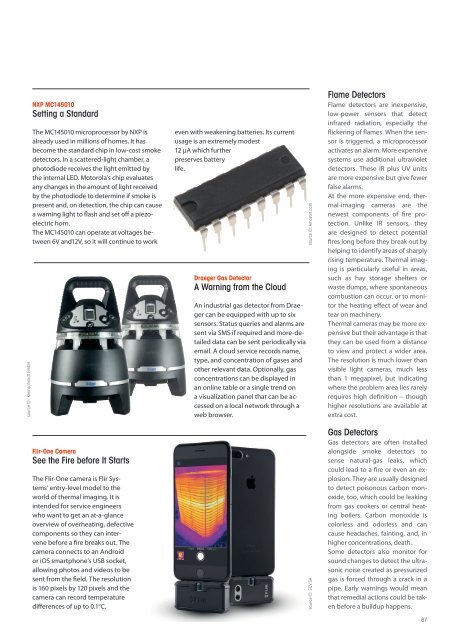Smart Industry 2021
Smart Industry 2021 - The IoT Business Magazine - powered by Avnet Silica
Smart Industry 2021 - The IoT Business Magazine - powered by Avnet Silica
- No tags were found...
You also want an ePaper? Increase the reach of your titles
YUMPU automatically turns print PDFs into web optimized ePapers that Google loves.
source ©: Kleinschmidt GmbH<br />
NXP MC145010<br />
Setting a Standard<br />
The MC145010 microprocessor by NXP is<br />
already used in millions of homes. It has<br />
become the standard chip in low-cost smoke<br />
detectors. In a scattered-light chamber, a<br />
photodiode receives the light emitted by<br />
the internal LED. Motorola’s chip evaluates<br />
any changes in the amount of light received<br />
by the photodiode to determine if smoke is<br />
present and, on detection, the chip can cause<br />
a warning light to flash and set off a piezoelectric<br />
horn.<br />
The MC145010 can operate at voltages between<br />
6V and12V, so it will continue to work<br />
Flir-One Camera<br />
See the Fire before It Starts<br />
The Flir-One camera is Flir Systems’<br />
entry-level model to the<br />
world of thermal imaging. It is<br />
intended for service engineers<br />
who want to get an at-a-glance<br />
overview of overheating, defective<br />
components so they can intervene<br />
before a fire breaks out. The<br />
camera connects to an Android<br />
or iOS smartphone’s USB socket,<br />
allowing photos and videos to be<br />
sent from the field. The resolution<br />
is 160 pixels by 120 pixels and the<br />
camera can record temperature<br />
differences of up to 0.1°C.<br />
even with weakening batteries. Its current<br />
usage is an extremely modest<br />
12 µA which further<br />
preserves battery<br />
life.<br />
Draeger Gas Detector<br />
A Warning from the Cloud<br />
An industrial gas detector from Draeger<br />
can be equipped with up to six<br />
sensors. Status queries and alarms are<br />
sent via SMS if required and more-detailed<br />
data can be sent periodically via<br />
email. A cloud service records name,<br />
type, and concentration of gases and<br />
other relevant data. Optionally, gas<br />
concentrations can be displayed in<br />
an online table or a single trend on<br />
a visualization panel that can be accessed<br />
on a local network through a<br />
web browser.<br />
source ©: Amazon.com<br />
source ©: SCV SA<br />
Flame Detectors<br />
Flame detectors are inexpensive,<br />
low-power sensors that detect<br />
infrared radiation, especially the<br />
flickering of flames. When the sensor<br />
is triggered, a microprocessor<br />
activates an alarm. More expensive<br />
systems use additional ultraviolet<br />
detectors. These IR plus UV units<br />
are more expensive but give fewer<br />
false alarms.<br />
At the more expensive end, thermal-imaging<br />
cameras are the<br />
newest components of fire protection.<br />
Unlike IR sensors, they<br />
are designed to detect potential<br />
fires long before they break out by<br />
helping to identify areas of sharply<br />
rising temperature. Thermal imaging<br />
is particularly useful in areas,<br />
such as hay storage shelters or<br />
waste dumps, where spontaneous<br />
combustion can occur, or to monitor<br />
the heating effect of wear and<br />
tear on machinery.<br />
Thermal cameras may be more expensive<br />
but their advantage is that<br />
they can be used from a distance<br />
to view and protect a wider area.<br />
The resolution is much lower than<br />
visible light cameras, much less<br />
than 1 megapixel, but indicating<br />
where the problem area lies rarely<br />
requires high definition – though<br />
higher resolutions are available at<br />
extra cost.<br />
Gas Detectors<br />
Gas detectors are often installed<br />
alongside smoke detectors to<br />
sense natural-gas leaks, which<br />
could lead to a fire or even an explosion.<br />
They are usually designed<br />
to detect poisonous carbon monoxide,<br />
too, which could be leaking<br />
from gas cookers or central heating<br />
boilers. Carbon monoxide is<br />
colorless and odorless and can<br />
cause headaches, fainting, and, in<br />
higher concentrations, death.<br />
Some detectors also monitor for<br />
sound changes to detect the ultrasonic<br />
noise created as pressurized<br />
gas is forced through a crack in a<br />
pipe. Early warnings would mean<br />
that remedial actions could be taken<br />
before a buildup happens.<br />
87
















